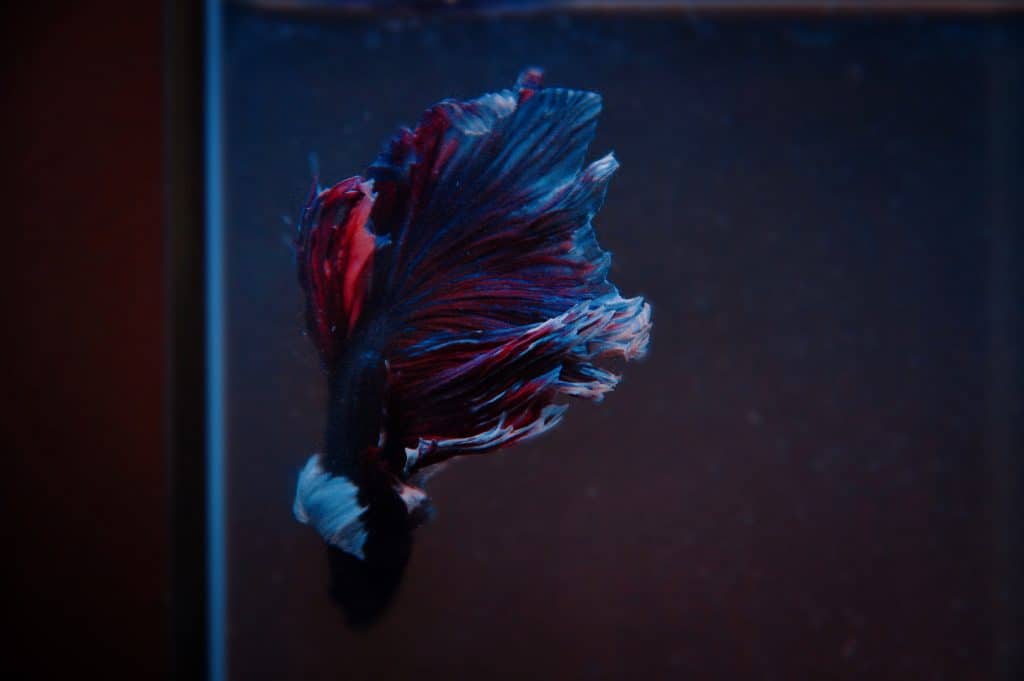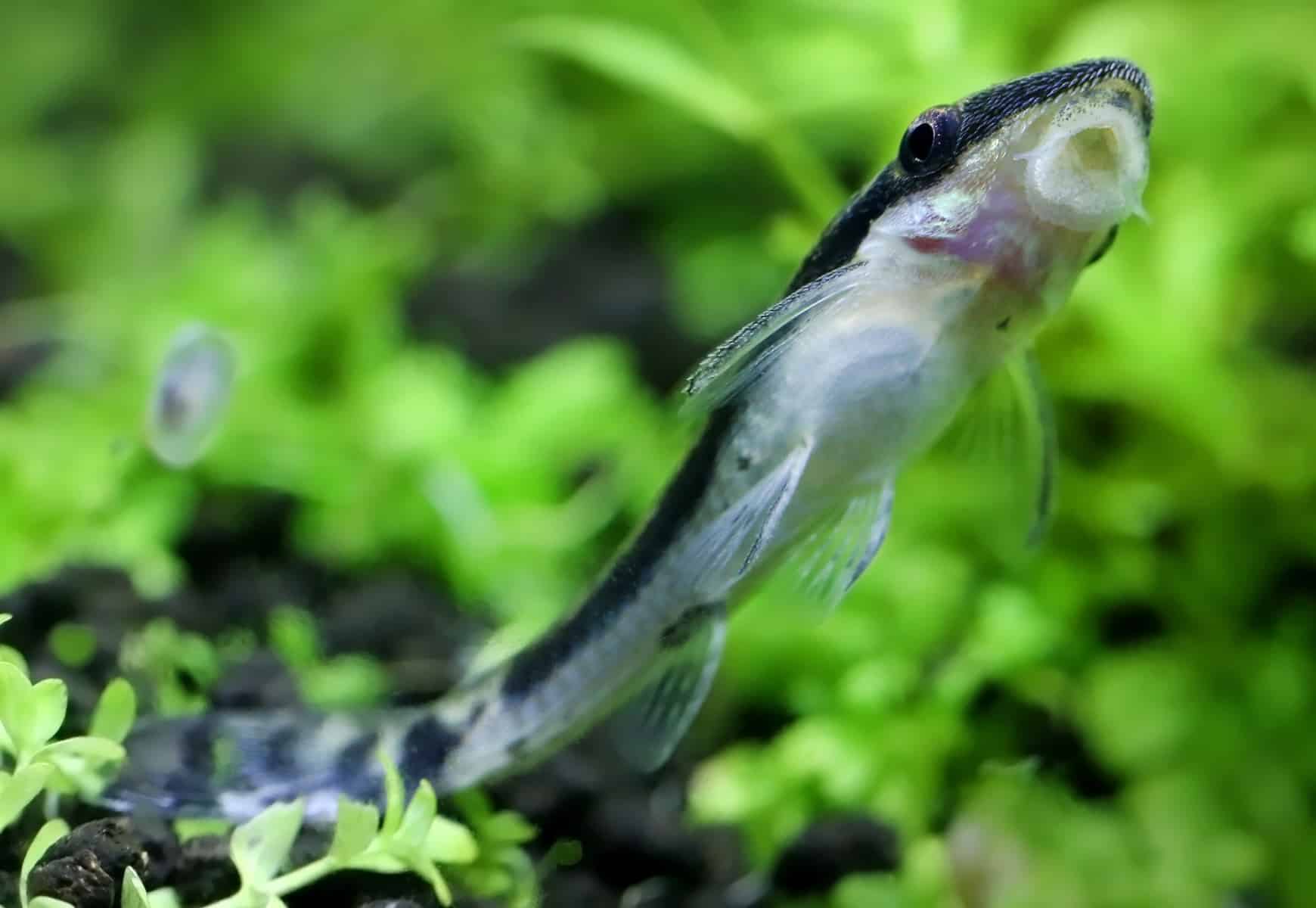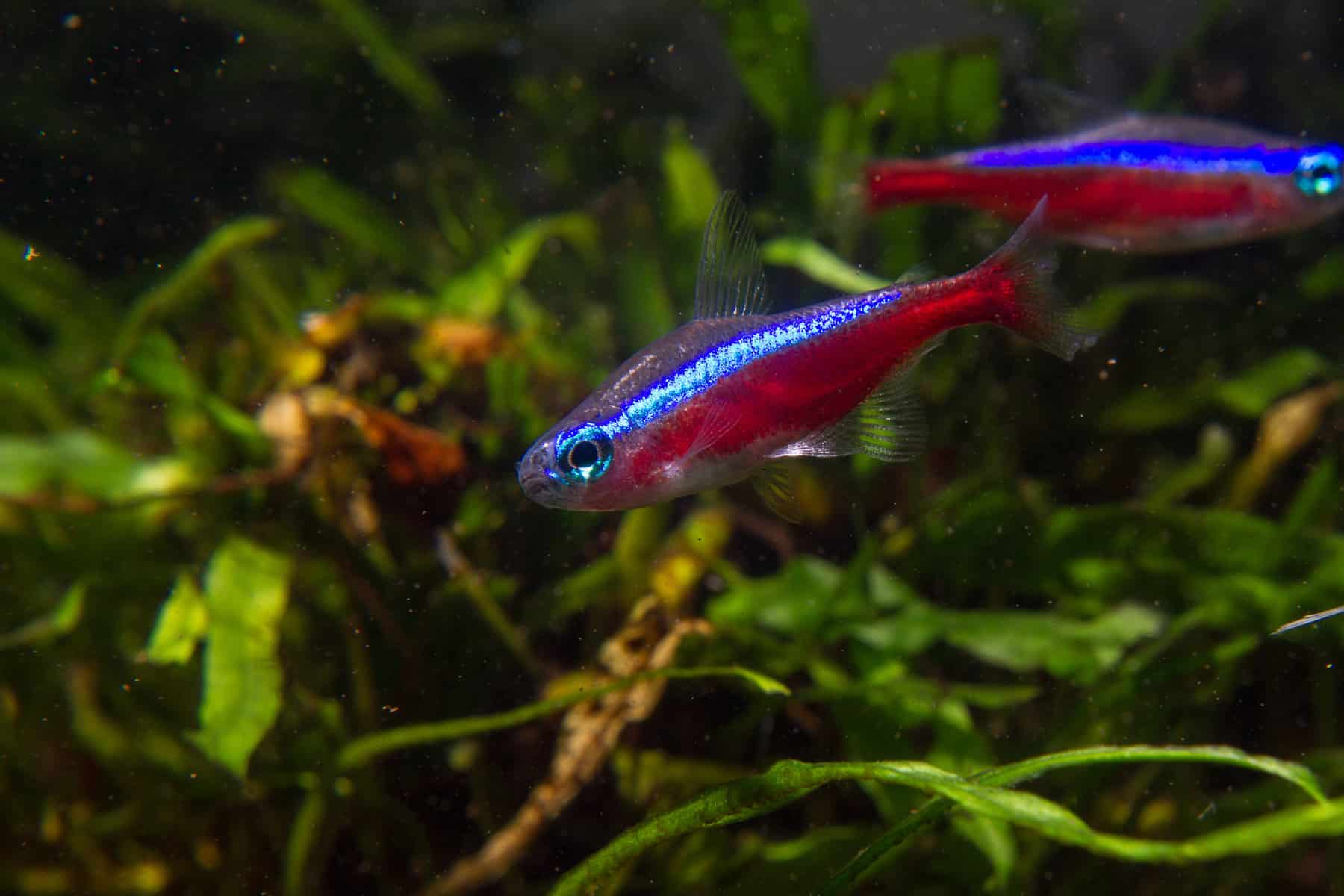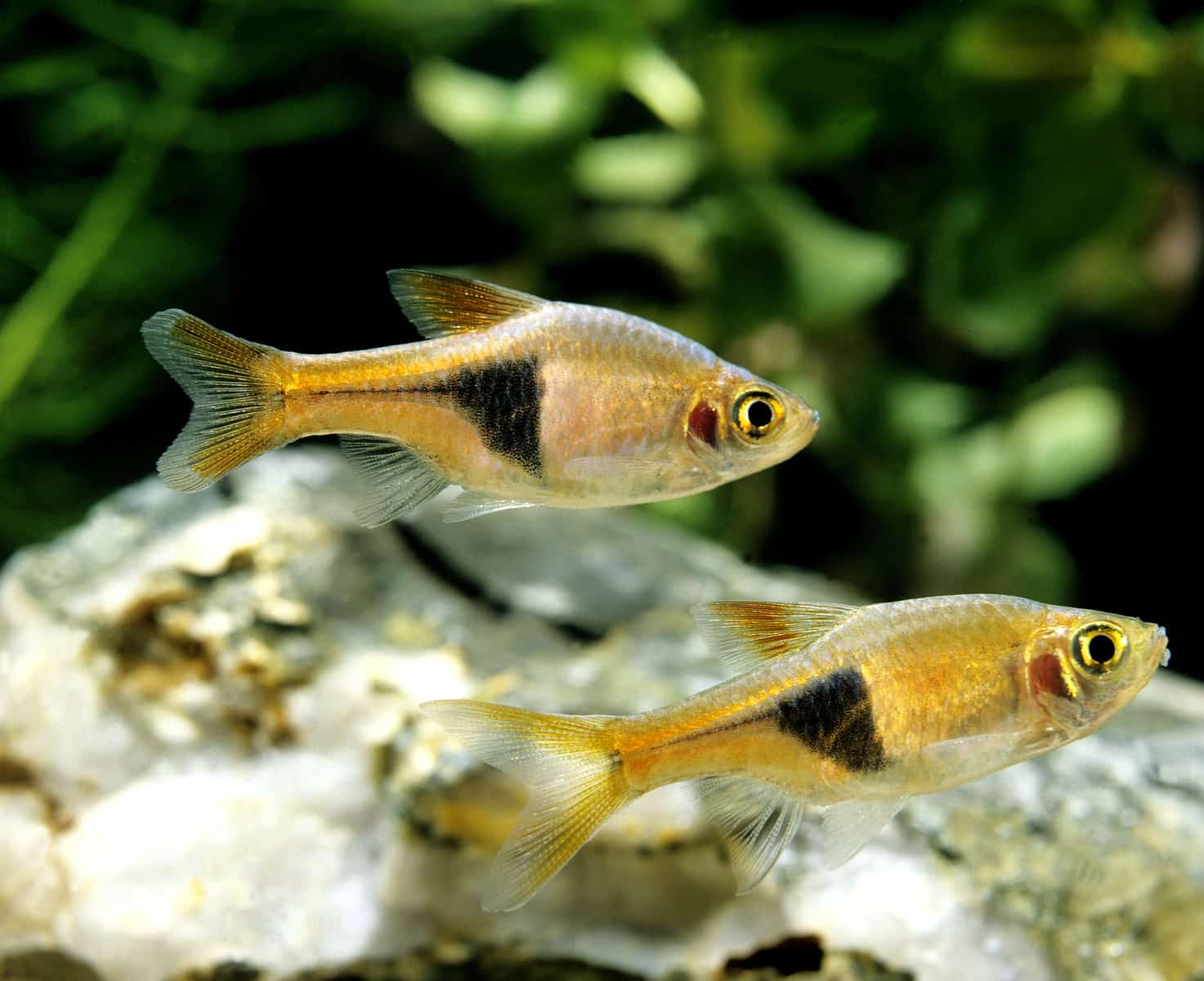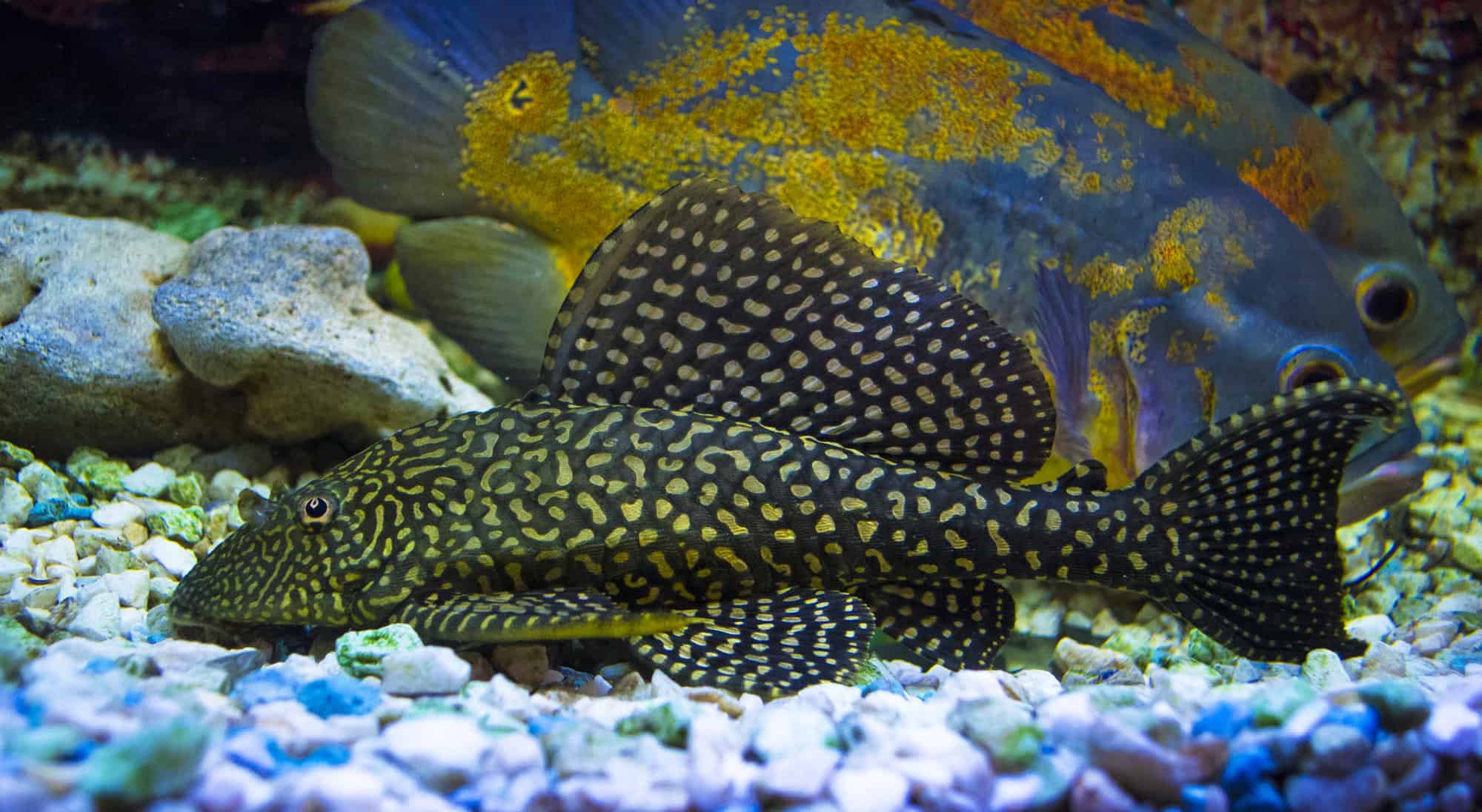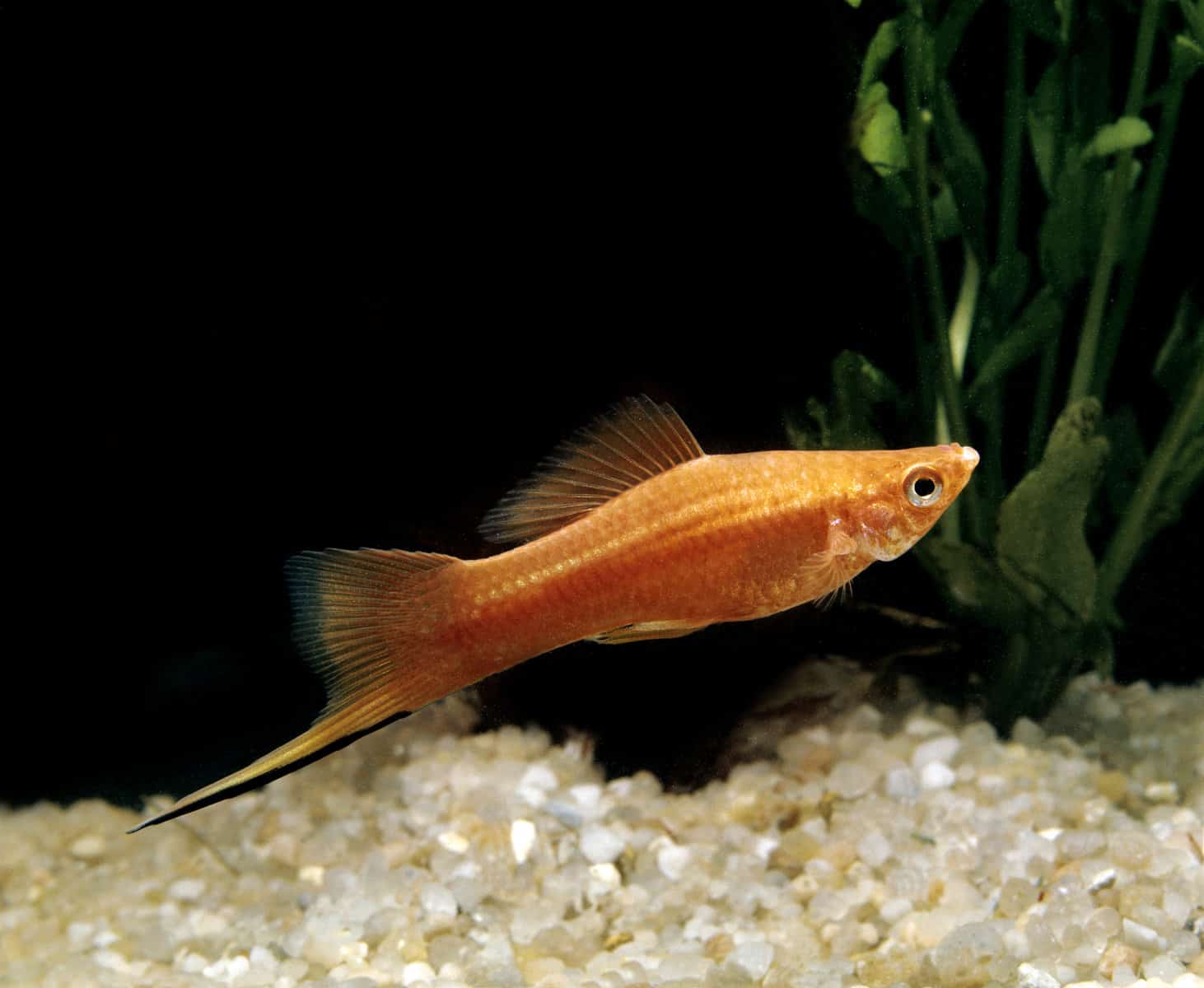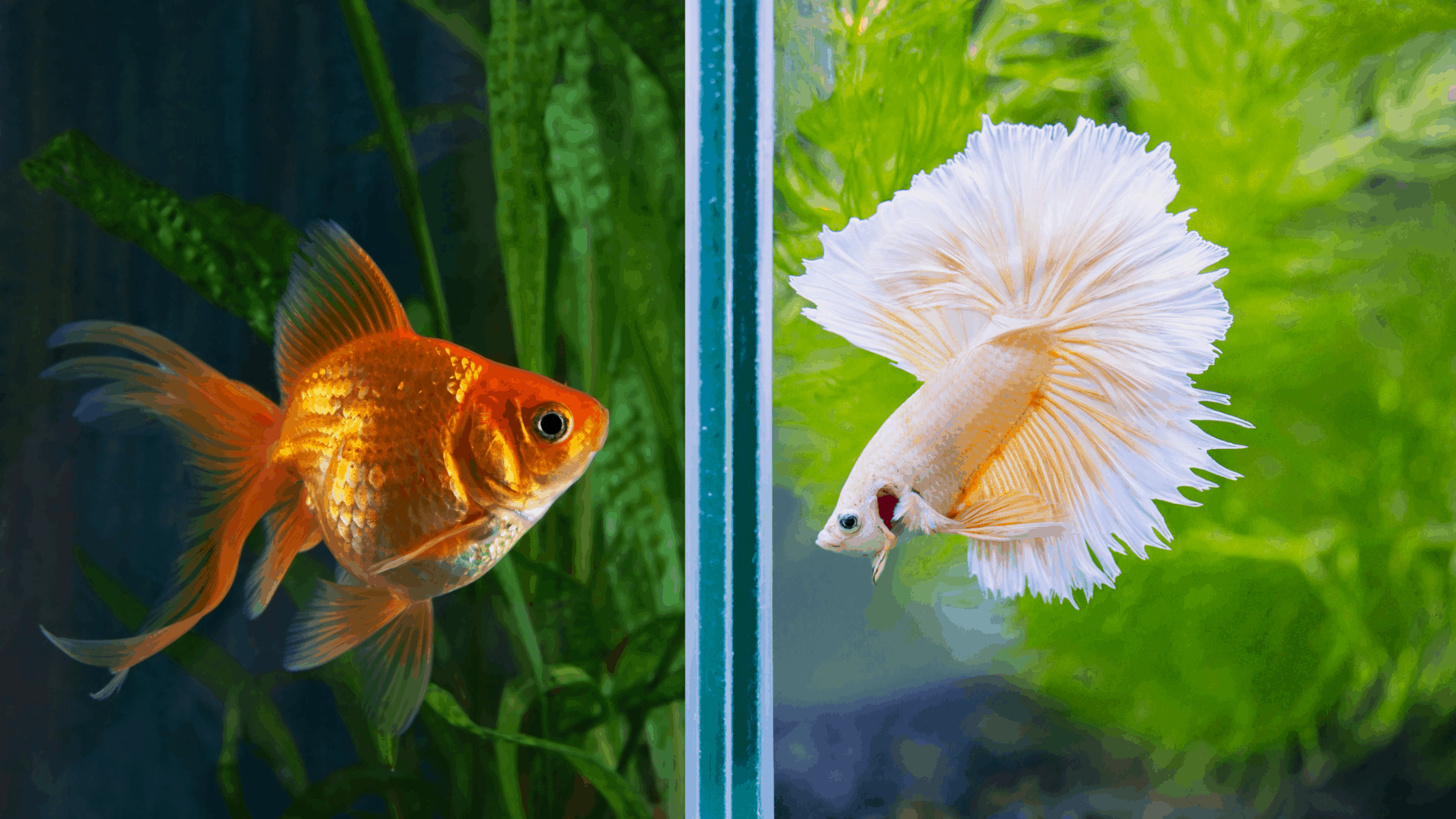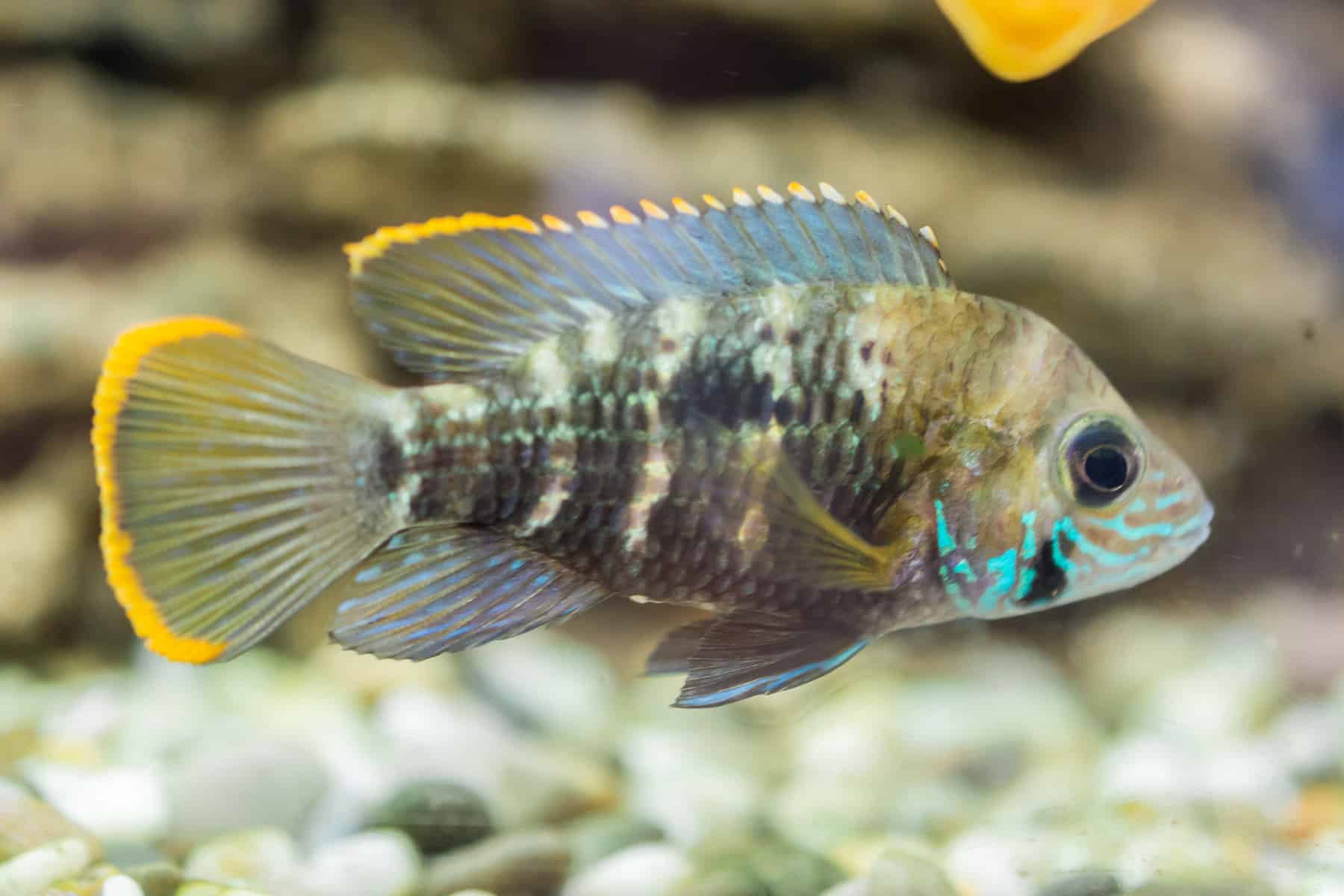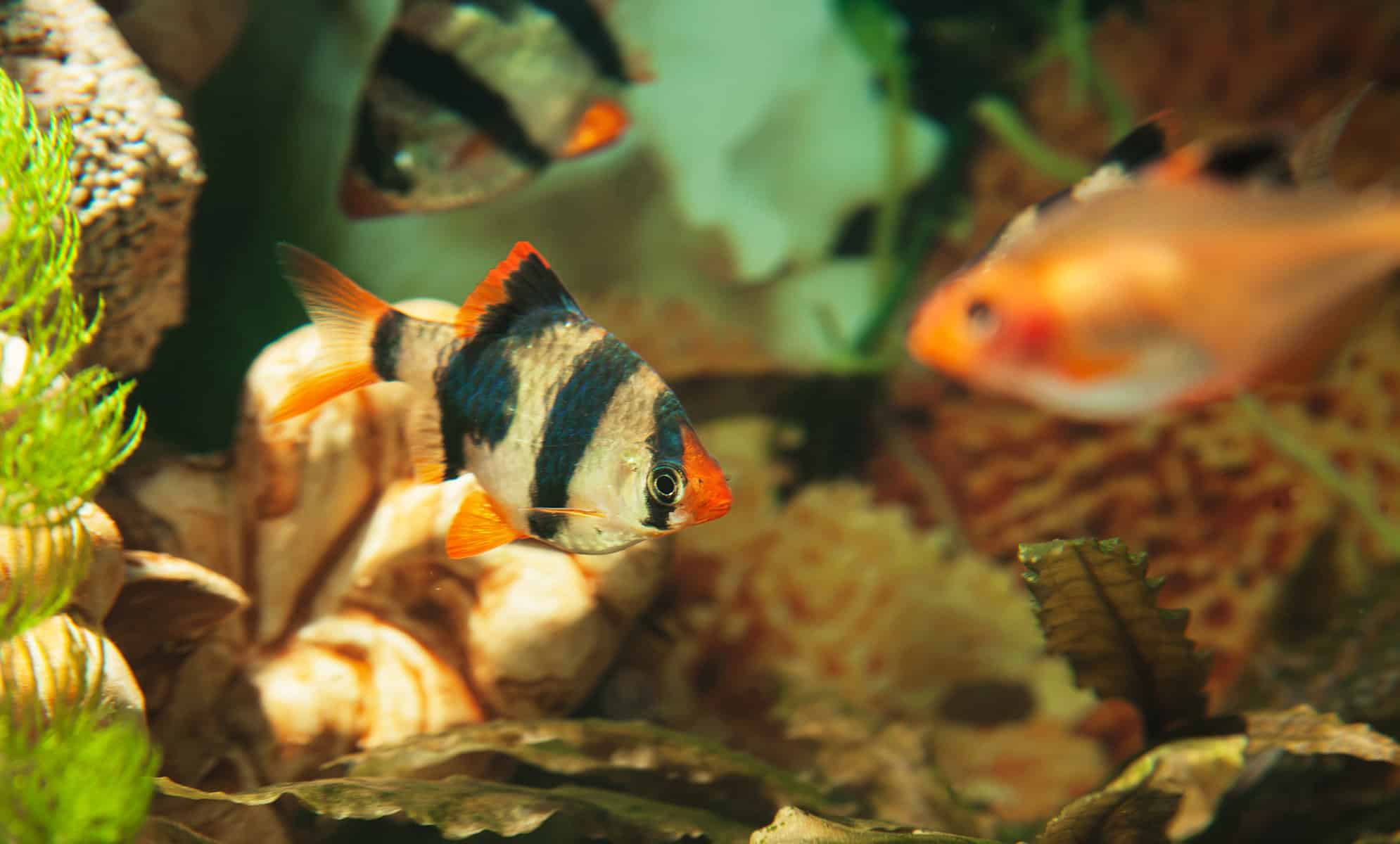Do betta fish need company in their tank, or are they happiest when kept alone?
Well, betta fish are also sometimes called Siamese fighting fish, and that’s for a good reason! Bettas are fiercely territorial, aggressively chasing away any interlopers on their patch and sometimes fighting to the death.
In fact, in Thailand, their country of origin, wild male bettas were originally kept and bred for fighting.
However, although you can’t safely keep two male bettas in the same tank, creating a peaceful community that your betta can share with a few suitable buddies is possible.
Read this guide to learn what fish and other creatures make the best tank mates for betta fish.
Do Betta Fish Need Companions?
Wild betta fish are pretty much solitary creatures, coming together only to spawn. They require plenty of space.
Wild male bettas choose a territory of around two to three square feet that they patrol daily, chasing away any rival males that try to encroach on their patch. So, do these aggressive fish need a companion in a captive situation?
Betta fish are intelligent, curious fish that can become stressed and miserable if not provided with plenty of entertainment in their environment.
That entertainment can take the form of activity outside the betta’s tank. For example, you might walk past a few times during the day, perhaps running your finger along the glass for your betta to follow.
Inside the tank, you need to provide plenty of plants for your betta to rest on and hide amongst.
Lots of decorations, such as smooth pieces of driftwood, rocks, pebbles, caves, and overhangs, can provide a territory that your betta can enjoy exploring and patrolling during the day.
Company
Another good way of providing interest for your betta fish is to give him some company in his tank.
Some bettas are pretty laid-back dudes that will happily accept the inclusion of a few small, peaceful fish or invertebrates in their home.
However, other bettas won’t tolerate intruders and are happiest kept alone. It really just depends on your betta’s individual temperament.
Betta Tank Mate Checklist
There are a few key things to keep in mind when choosing suitable tank mates for your betta fish, including:
- Ensuring that the species can live comfortably in the size tank you have.
- Ensuring that the tank mate shares the same water conditions and parameters as your betta fish.
- Avoiding any brightly colored fish and those with flowing finnage that could be mistaken for another betta fish by your pet.
- Avoiding fin nippers.
It‘s also helpful to choose creatures with the same or similar dietary requirements as your betta fish. This helps to prevent food waste and save you money in the long run.
Betta Temperament
Although this may sound strange to people that have not had more than one betta fish, you want to keep your pet’s specific personality in mind when choosing tank mates.
Each betta fish has characteristics that are different from another. That can mean that a certain species of tank mate may get along fine with one betta and then terribly with another.
Some betta fish seem aggressive, while others will be calmer in general. Overly aggressive bettas should be housed by themselves to prevent accidents. However, shy bettas will probably get along better with another type of friend.
You must consider that wild betta fish are solitary creatures living alone. A betta stakes his claim on a certain area of water and protects and defends it as its life depends on it.
Bettas also have the choice in the wild to pick and choose what is allowed inside their patch.
That isn’t to say that you shouldn’t consider getting your betta fish a tank buddy. You just need to keep in mind what kind of personality your betta has.
When introducing a new tank mate to your betta’s aquarium, keep a close watch on how the two creatures interact, and be ready to remove the newcomer if trouble looks likely.
Betta’s Best Friends – Top Recommendations
In this part of our guide, we take a look at a range of different creatures that can make suitable tank mates for betta fish.
Freshwater Snails
Snails are easily the best option on this list. These peaceful mollusks have body armor that keeps them safe from betta fish mood swings.
Bettas are curious about everything in and surrounding their tank. When betta fish get curious about something, they often act like toddlers and put whatever they discover into their mouths. And yes, betta fish have teeth!
There are many types of freshwater aquatic snails that you can usually find for sale in a well-stocked pet shop. Apple snails are one; nerite snails are another.
Apple snails tend to come with beautiful colors and markings. If given enough space and proper care, apple snails can reach softball-size proportions.
Wait, that was wrong of me. I should have said that they can reach apple-size proportions. Anyway, keep that in mind when considering your aquarium’s size.
On the other hand, nerite snails usually only reach about an inch in size. Nerite snails work well as a housekeeping service for betta fish because they are scavengers.
Algae is the main course for the nerite snail, which works well for both the betta and the owner. The snail’s shell patterns can vary and make for very interesting additions to the tank.
If you are considering getting a snail for your betta tank, keep in mind that all snails are highly sensitive to copper.
While this may not seem a big concern to you at first, take note that there are medications for your betta that have copper as an ingredient. You do not want to heal your betta and harm your snail by proxy.
The easy workaround is to medicate your betta in a separate hospital tank while leaving your snails in the main aquarium.
Shrimp
Shrimp make for an interesting choice of tank mate for a betta. Although your betta is primarily carnivorous, he will find most adult shrimp too big to view as a food source, so these interesting crustaceans should be safe.
Red Cherry shrimp are one of these types, and Ghost shrimp are another type that survives fairly well in a betta’s aquarium.
As their name implies, Ghost shrimp have translucent bodies. This is fortunate for the Ghost shrimp as that constant camouflage makes them harder to spot by an overly ambitious betta fish.
Shrimp leave very little in terms of waste. Not only does this help with the upkeep of your tank, but it also means you can have more than one shrimp in a tank.
One thing to watch out for is that shrimp tend to enjoy breeding. If you were to start with 10 shrimp, after about a month, you might have more shrimp than water in the betta tank!
Some people see this as a profitable problem to have as you can certainly sell the shrimp if you find you have a market for them.
Shrimp also like keeping the aquarium algae-free as their stomachs can handle it. They do a decent job for their size in keeping down the algae growth.
Overall, if you were to have to choose between one of the two types of shrimp mentioned, I’d recommend the Red Cherry shrimp as they are the more attractive option of the two.
African Dwarf Frogs
African Dwarf frogs can make fine friends with betta fish. It’s not so much that the two species become friends; they just ignore each other.
The African Dwarf frogs tend to do their thing, and the betta fish does its separate thing. Fighting (or eating) between the two rarely, if ever, breaks out.
These amphibious tank mates don’t tend to produce much waste. Because of this, your concern over elevating water parameters caused by the breakdown of excess waste is minimal.
Feeding time is the main concern when you have African Dwarf frogs and a betta in the same tank.
It is either that betta fish are fast swimmers or that these frogs are on the slow side of the kiddie pool, but either way, the betta will be more likely to finish its food before the frog even finds its own.
Betta fish don’t care about whose food is whose and will tend to eat anything and everything edible. Just try to keep an eye out for your frog and ensure that it is getting fed.
Corydoras Catfish
Corydoras catfish or Corys are yet another fine tank-mate possibility. There are over 100 different types of Cories that you can choose from, but they all share something in common. They are bottom-feeding fish.
Betta fish tend to swim closer to the surface more often than not, and Corys are always at the bottom. Because of this, fighting due to territorial disputes rarely happens.
Corys are a particularly peaceful species of fish in general and these mini catfish should always be kept in groups of at least five individuals.
So, a 10-gallon betta aquarium could do fine with three or four Corys. Anything less than ten gallons would be too small for these active little fish.
So far, Cories are the only type of fish species on this tank mate guide. However, they are at the top of the list of fish species that can share a tank with your betta.
They are very easy keepers and quite peaceful as well. These are both very good things to look for. Nobody wants a betta tank full of drama!
Otocinclus Catfish
Also in the catfish family, and would likewise do well with a betta, is the Otocinclus catfish. Otos share many similar characteristics with Cory cats.
Otos, however, are sometimes quite difficult to acclimate to the aquarium. This tends to be the case more often than not because they are not commonly bred and raised in captivity.
Believe it or not, Otos are often caught straight from the wild. Changes to the aquarium environment, such as overall water condition or temperature, might cause problems for Otocinclus catfish.
A general rule of thumb with these fish is that if you can keep your Otos alive for a week or two, they should settle in and do well thereafter.
Loaches
There are several different kinds of loaches that you could keep safely with bettas. Keep in mind that many loach species are nocturnal, so you won’t see much of them unless you have moonlight mood lighting in your betta’s aquarium.
Some loach species you might like to consider include:
- Hillstream loaches
- Khuli loaches
- Zebra loaches
- Dwarf loaches
Loaches can also grow pretty large, depending on the species, so you must carefully research your preferred variety before taking one home.
White Cloud Mountain Minnows
White Cloud Mountain minnows are similar to the common Neon tetra in terms of appearance and overall size, but they are not quite as brightly colored and flashy and are not known as fin nippers.
A convenient feature of the White Cloud Mountain minnow is that they share similar tastes for the temperature of the aquarium as a betta fish does.
Well, they like the temperature to be anywhere between 68°F and 78°F, which is pretty close to the 78°F to 80°F target temperature for betta fish. These minnows are renowned for being hardy.
The fish are great eaters and acclimate well to their new environment. They are fairly easy keepers overall and are a fine choice for a beginner looking to house more than a betta in a tank. These minnows are fast breeders, so you must keep an eye on the population.
Runners Up – Decent Betta Tank Mates
The following species missed the blue ribbon list above by a small margin.
Consider these species decent tank buddies for your betta but slightly less co-habitable than the ones listed above.
Neon Tetras
Starting off the runner-up list is the Neon tetra. We are starting here because these fish share the same characteristics as the White Cloud Mountain minnow.
The major difference, and why they didn’t make the top list, is that Neon tetras are very brightly colored and renowned as fin nippers.
Rasboras
Rasboras share similar characteristics with tetras and can do well sharing an aquarium with a betta fish. Rasboras are typically a more gentle fish in terms of peaceful living with a betta, and they don’t tend to be fin nippers.
Plecos
It should be noted right from the start that we are not suggesting the Common pleco. Common plecos can reach up to 2 feet long and are not recommended for obvious reasons.
However, smaller species of plecos can work quite well when sharing an aquarium with a betta fish. The mini-me versions of the Common pleco that generally get along fine sharing a betta tank include:
- Pit Bull pleco
- Clown pleco
- Rubber Lipped pleco
- Bristlenosed pleco
These plecos generally grow no larger than 5 inches. Even though that is considerably smaller than the 2-foot pleco mentioned above, you wouldn’t want more than just one pleco in a 10-gallon betta tank.
Plecos can help keep the betta tank clean as they love to eat algae. These fish keep their distance from the betta fish and are relatively non-invasive overall.
In addition, plecos come conveniently equipped with some really tough body armor. So, an angry betta fish can’t do too much damage to an accidentally intruding pleco.
The Maybes – Doable But Not Recommended
This next group of betta tank mate possibilities consists of species that can, in some cases, live alongside betta fish but are generally not recommended.
As you will see, in almost every case, you will not want to try keeping these as tank mates with a betta.
Mollies
These live-bearers are similar to platies in that they enjoy, or need, water that is relatively hard and keeps a high pH level.
If you have done your homework on betta fish, you will instantly see why this poses a problem. Betta fish need pretty much just the opposite of this.
On top of that, mollies are quite aggressive at times. Generally, aggression from mollies occurs when there is inadequate space in the tank to divvy up the territory between a betta and itself. Mollies can reach 3 inches if raised in a five-gallon aquarium.
If you desperately want to keep mollies in the same tank as a betta, the lesser of two evils are the type of mollies with shorter tails. Mollies with long, flashy tails are far more likely to trigger aggression in betta fish.
Platies
Like mollies, platies like their water on the harder side with a high pH level. Platies are also notorious nippers of fins. So, your poor betta fish might not have glorious long finnage for long if you decide to go with platies as tank mates.
Guppies
The main issue with guppies is that males are brightly colored, which can attract the attention of a feisty betta fish.
Male guppies also have long tails that flutter and float as the fish swims along, which could lead to mistaken identity and fighting.
Guppies sold as feeder fish tend to be less brightly colored than Fancy guppies. However, these fish carry transmissible diseases you don’t want in your betta tank. So, all in all, we think it’s better to avoid guppies altogether.
Swordtails
Like the fish species mentioned above, swordtails prefer water with high pH levels and on the alkaline side.
Unlike betta fish, swordtails prefer fast-moving waters. In contrast, betta fish like their environment relatively motionless as far as currents are concerned.
Aside from environmental differences between bettas and swordtails, an aggressive betta fish would most likely try to attack the swordtails’ very attractive, flowing fins.
The NOPE List – Don’t Even Go There!
Unless you are truly sadistic, don’t think about choosing any of the following as tank mates for your betta fishy. Ok, maybe sadistic was too strong a word. But you get the idea.
Goldfish
I debated putting the possibility of goldfish living with bettas at the top of this entire article, as it’s one of the most common questions I get asked about betta tank mate possibilities.
However, it will have to live at the top of this section instead. Don’t do it!
The first problem is that goldfish are coldwater fish preferring water in the 60°F range. If you put a goldfish in a betta tank with very warm water, the goldfish will probably suffer from temperature shock that could kill it.
Goldfish are very messy fish that produce a lot of waste. That means these fish need a powerful filtration system and a large tank of at least 20 gallons.
Your betta prefers still water or a very gentle flow. Basically, the two species simply don’t mix.
Cichlids
Cichlids are awesome fish to keep, just not in the same aquarium as a betta fish!
These guys suffer from a pretty aggressive mindset. What happens when you put an aggressive fish in with another aggressive fish?
Carnage would most likely occur if you were to keep a betta fish with a group of cichlids.
If the aggressive nature of the cichlid isn’t enough to dissuade you from housing one in a betta’s tank, learning that they have a hard time living in the same water conditions as a betta might.
Cichlids like living in waters that have a high pH balance, whereas betta fish need to live in a low pH environment.
So, the two species have totally different needs regarding water parameters, and they’re simply incompatible.
Gouramis
Betta fish and gouramis don’t get along well in the same tank. Gouramis are like distant cousins of the betta fish, belonging to the same family.
Betta fish don’t get along with their relatives, and you don’t want to house these two types of fish together.
If bettas’ tendency to get cranky at their relatives isn’t enough, gouramis are fairly aggressive fish themselves. So, putting two aggressive-natured fish together is simply asking for trouble.
Tiger Barbs
I highly recommend that you experience Tiger barb ownership at least once in your life! These guys are highly entertaining fish, but not in the same tank as a betta fish.
Tiger barbs and betta fish are not good tankmates. They are both aggressive creatures that will almost certainly fight if kept together. Tiger barbs are serial fin nippers and will quickly shred your poor betta buddy’s beautiful finnage into ribbons.
Chinese Algae Eaters
Chinese algae eaters pretty much make for bad tank mates in any group housing situation. These fish suck on other fish, literally. That is not something you want your betta to experience!
Chinese algae eaters tend to be aggressive fish, and their mood seems to get worse as they grow in size.
Over time, your betta fish will lose its (apparently flavorful) slime coating to these fish. Bettas that lose their slime coat are then susceptible to disease.
So, Chinese algae eaters and betta fish shouldn’t be kept in the same tank.
Other Betta Fish
You should only ever consider keeping more than one betta fish in an aquarium when you want to start building a sorority tank.
Sororities in the betta world are groups of female betta fish. You never want to house more than one male betta fish at a time in the same aquarium.
These fish will take after their other common name and act as Siamese fighting fish.
If you are interested in starting a sorority of female betta fish, it’s not as easy as just grouping a bunch together. You need to read on the subject beforehand, as the girls can sometimes be just as feisty as the boys.
Can Bettas Live in Pairs?
It’s generally not recommended to keep a pair of one male betta and one female. From personal experience, this can lead to the female being harassed by the male.
Alternatively, the male might show no interest in mating with the female, even attacking her to the point of serious injury or death.
So attempting to breed bettas simply by putting a female and male betta fish together is not recommended.
Final Word
There you have it, our top-to-bottom recommendations on betta fish tank mates. This tank mate overview article is a generalized guide for selecting different species that could live with a betta.
However, you should remember that each species has unique care needs, and you will need to research this before making your final selection.
Also, remember that just because one of the species listed near the top is generally accepted in a betta fish community tank, it doesn’t mean that your specific betta fish will get along fine with it.
You must be very observant of whatever situation you put your betta fish in. The final call on whether or not tank mates are a good decision in your given situation remains only your own.
